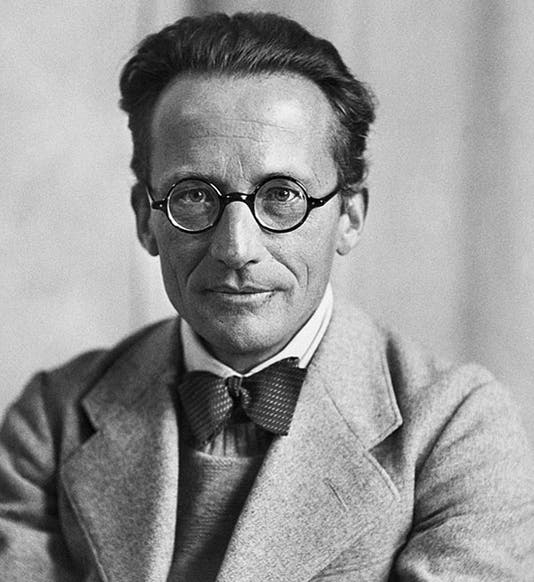Scientist of the Day - Erwin Schrodinger
Erwin Schrödinger, an Austrian physicist, was born Aug. 12, 1887. When Schrödinger came into physics, quantum theory was about 20 years old. It was known that energy is not continuous, but is passed back and forth in small packets, called quanta, which explained such things as why electrons in an atom could only be found in certain energy states, and why, when electrons moved from state to state, the atom emitted only certain discrete wavelengths of light. By the early 1920s, it was suspected not only that waves have particle-like properties, but that particles, such as electrons and protons, have wave-like properties as well. What Schrödinger showed in 1926 was that one could describe a hydrogen atom by an equation, a wave equation, the solutions of which would perfectly predict the energy states of the atom. This marked the beginning of what is often called wave mechanics, the true flowering of quantum physics. For this, Schrödinger shared the Nobel Prize in Physics in 1933. After Schrödinger, the big question was: what do the wave functions in the wave equation physically mean? Schrödinger's own view was that the wave function of an electron represents the probability that you will find that electron at a particular place in the atom. That was disconcerting (to non-quantum physicists) because it means that you actually do not know – and can never know – exactly what an electron is doing or where it is – you can only make a calculated guess. In the 1930s, there arose an interpretation of wave mechanics that came to be called the Copenhagen interpretation, because it came out of Niels Bohr's Institute in Copenhagen, with Bohr as its principal proponent. The Copenhagen interpretation said that an electron (or whatever is being described by a wave equation) is in all those places at once; there is a superposition of electrons at every point predicted by the wave equation. It is only when you physically observe the electron that the wave equation "collapses" to yield just one position. That seemed difficult for many (such as Albert Einstein) to swallow – how can the mere act of observing alter the state of an observed body? The answer – that's just the way the world is, when viewed at the quantum level – did not please everyone. Schrödinger, in particular, was not happy with the Copenhagen interpretation, so he proposed a counterexample, in the form of a thought experiment – one of the more famous thought experiments in the history of science. Suppose you put a cat in a sealed box, and the cat shares the box with a bit of potentially radioactive material (the behavior of which is described by quantum mechanics). If a particle is emitted, it is detected by a Geiger counter, which in turn triggers a device that shatters a bottle of cyanide, which kills the cat. The wave equation for the box describes two states, one where the particle is not emitted and the cat is alive, and one where the particle is emitted and the cat dies. According to the Copenhagen interpretation, both states are superimposed until the box is opened and the cat is observed, so the cat is at once both alive and dead, and only when you open the box does the situation collapse to one state. The conundrum of Schrödinger's Cat has given to nearly continuous debate since 1936, when Schrödinger first proposed it, as well as innumerable cartoons (here is a clever example), T-shirts, posters (second image), YouTube videos, and jokes.

Schrödinger’s cat, cartoon poster (astronomicalreturns.com)
Of the jokes, I like the following (actually the tail end of a longer joke also involving Werner Heisenberg, which I pruned down for the occasion): Schrödinger was stopped by a highway patrolman, who asked to look in the trunk of his car. Schrödinger gave him the key. The patrolman opened the trunk, then came back to the side of the car and said: “Hey, there’s a dead cat in your trunk.” Schrödinger angrily replied: “There is NOW!” In 1944, Schrodinger published a book for the lay public called: What is Life? The Physical Aspect of the Living Cell. The book provided one of the first attempts to apply physical principles, in particular quantum mechanics, to organisms, and was specifically mentioned as an important influence by James Watson and Francis Crick in their search for the mechanism of inheritance. This might be a fruitful subject for a future post. Dr. William B. Ashworth, Jr., Consultant for the History of Science, Linda Hall Library and Associate Professor emeritus, Department of History, University of Missouri-Kansas City. Comments or corrections are welcome; please direct to ashworthw@umkc.edu.






